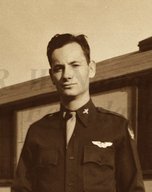
|

|
|
|
|
George was born at home in Linden, Texas as one of two children of Earl Bennett, a banker and retail store owner, and Alma George Bennett, whose father owned two cotton gins. George tried picking cotton as a child. "I didn't do much good," he recalls. I couldn't pick it fast enough." He took baths in a "number three washtub" and lived in a house lit by coal oil lamps until electricity was installed. He recalls listening to the radio, going to movies on Saturday, and attending a Baptist church on Sunday. George graduated from high school in 1941 as valedictorian in a class of fifty-six. He attended College of Marshall (now East Texas Baptist University) in Marshall, Texas. "The first fall I was there Pearl Harbor was attacked. So from then on we knew we were going to be in a big war," he states. He left the school after a year, attended the University of Texas at Austin for one semester, then enlisted in the U.S. Army Air Forces in November of 1942. In February of 1943 he began basic training at Sheppard Field in Wichita Falls, Texas. He then was sent to the University of Denver in Colorado where he took physics. After pre-flight school in Santa Ana, California, and gunnery school in Las Vegas, he entered navigation school in Hondo, Texas, where he was commissioned a second lieutenant in May of 1944. After radar school at Boca Raton, Florida, he was assigned to a B-29 Superfortress. He left the States in early 1945 for Tinian, where he joined 1st Air Squadron, 9th Bombardment Group, 20th Air Force. George flew missions over Japan usually twice a week and mostly at night. He believes the B-29 carried loads of "ten or twelve" 500-pound bombs. On one mission some of the bombs stuck in the bomb bay, exploding in "four separate and distinct explosions" that hurled the plane around. He recalls, "it lifted me as if I were a mere straw up to the ceiling until my head hit and dropped back four times." No one was badly hurt. George says he had no knowledge of the atomic bomb before it was dropped, although the plane that carried it flew from Tinian. "They kept it a secret from everybody," he says. George flew twenty-four missions, the last on August 14, 1945. He returned home on the USS Hamblen (APA-114) arriving in Los Angeles in November of 1945. Discharged in San Antonio, he enrolled in medical school at Tulane University, using the GI Bill. On June 8, 1950 he married Inagene McMillan. (They would have three children and four grandchildren.) George finished medical school in 1951 and served a year's internship at Charity Hospital in Shreveport. The couple moved to Marshall where George took over a practice, in which he remained for "forty-eight years and eight months." He recalls of his service experience, "It helped mature me and it strengthened my religious views, I'd say. I always had confidence that God had a plan for me, though, and that I would not be killed. I felt confident all the time." |


